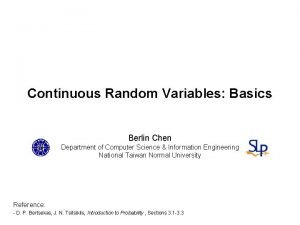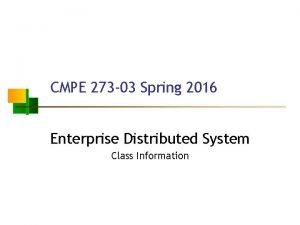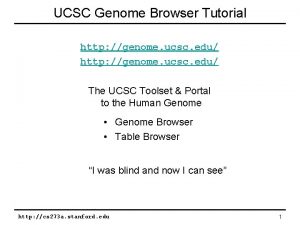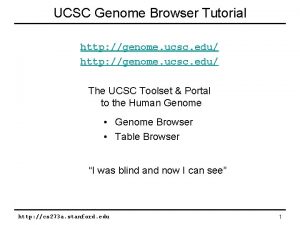CMPE 252 A Computer Networks Chen Qian UCSC































- Slides: 31

CMPE 252 A : Computer Networks Chen Qian UCSC Baskin Engineering Lecture 18 Some slides from Brent Waters and Saiyu Qi 1

Scalable Data Access Control in RFID-Enabled Supply Chain Saiyu Qi 1, 2, Yuanqing Zheng 2, Mo Li 2, Yunhao Liu 3 , Jinli Qiu 4 HKUST 1 NANYANG TECHNOLOGICAL UNIVERSITY 2 TSINGHUA UNIVERSITY 3 XI’AN JIAOTONG UNIVERSITY 4 2

Introduction of RFID technique Basic components of RFID: Ø RFID Tag: Ø low cost Ø limited storage ability Ø support wireless communication Ø RFID Reader: Ø moderate-ability Ø retrieve tag carried data via wireless channel The global forecast of RFID Ø Database: hardware, middleware and IT Ø Connect with reader market Ø store detailed tag data Ø tag identification/authentication----Source from Dolcera. Wiki 3

RFID-enabled supply chain 1 shared among supply chain participants 2 3 4 1 2 3 4 5 6 7 8 9 5 6 8 7 9 4

Motivation Ø The product data derived by RFID tags is usually sensitive Ø An instance: pedigree of drugs Ø created for each tagged drug in a pharmaceutical supply chain Ø be useful to verify if a drug is fake Ø often contains counterfeit certificate , time of delivery and manufactures suffer malicious accesses by drug counterfeiters and competitive manufacturers 5

The goal of this paper Ø Secure sharing of RFID-derived product data Ø A scalable data access control system for RFID- Enabled Supply Chain Ø an item-level data access control mechanism Ø an item-level privilege revocation mechanism Ø Advantages: Ø data access control in item-level Ø scalable to large amount of tagged products 6

System model product data is sensitive and may be compromised A participant only needs to contact the provider to retrieve the data of others We aim to provide item-level access idxi, <Enc(wit, Ki)>sig policy for product data defined by participants 7

Item-level data access control: a strawman method Not scalable to support large-scale tagged products Some participants are unknown in advance 8

Item-level data access control: our idea Consider a tagged product flowing through the supply chain… Ø Submit policy enforced encryption: Ø encryption associated with an access policy Ø Policy definition: Ø two types of attributes: role attribute (etc, USA, Retailer) and tag attribute (used as tag ID) Ø logical expression over role attributes AND tag attribute Ø e. g. , (‘retailer’ AND (‘USA’ OR ‘France’) AND ‘Tag. Att’) 9

Item-level data access control: our idea Ø Decryption condition of policy enforced encryption: Ø a credential with satisfiable role attributes and a credential with the tag attribute Ø Distributed credential management: Ø role attributes /credentials ------a key authority Ø tag attributes/credentials------corresponding tags (only participants within the supply chain can acquire!) Ø A participant can acquire: Ø one credential with a set of role attributes to describe itself from the key authority Ø credentials of tag attributes from tags 10

Item-level data access control: an example role attributes published by key authority tag attribute from tag within the supply chain but unsatisfiable role attributes Location: USA Obligation: retailer Tag. Att Location: France Obligation: producer Tag. Att credential issuing of role attributes Location: USA Obligation: retailer outside the supply chain 11

Item-level data access control: advantage Ø Advantages: Ø define an access policy with role attributes (acquired from the key authority) and tag attributes (acquired from tags)---do not need knowing other participants in advance Ø participants acquire credentials from key authority and tags --- item-level key issuing is avoided 12

Item-level data access control: implementation Ø Policy enforced encryption: Ø Double encryption pattern: Ciphertext Policy-Attribute Based Encryption (CP-ABE) [Bethencourt, et al. , SP '07] and Updatable Encryption (UE) scheme ABE encrypt the data Symmetric encrypt the ABE encryption Precisely enforce our desired policy: ABE to enforce role attribute part Updatable encryption to enforce tag attribute part Product data ABE encryption Policy enforced encryption Ø Two types of credentials: ØCredentials with role attributes: ABE private keys ØCredentials with tag attributes: UE private keys 13

Ciphertext-Policy, Attribute-Based Encryption John Bethencourt CMU Amit Sahai UCLA Brent Waters SRI International

Remote File Storage: Interesting Challenges o Scalability o Reliability o … But we also want security 15

Remote File Storage: Server Mediated Access Control Sarah: IT department, backup manager ? o Good: n Access control list: Kevin, Dave, and Flexible anyone accessinpolicies IT department o Bad: n Data vulnerable to compromise n Must trust security of server 16

Remote File Storage: Encrypting the Files o More secure, but loss of flexibility o New key for each file: n Must be online to distribute keys o Many files with same key: n Fine grained access control not possible 17

Remote File Storage: We Want It All o Wishlist: n Encrypted files for untrusted storage n Setting up keys is offline n No online, trusted party mediating access to files or keys n Highly expressive, fine grained access policies o Ciphertext-policy attribute-based encryption does this! n User private keys given list of “attributes” n Files can encrypted under “policy” over those attributes n Can only decrypt if attributes satisfy policy 18

Remove File Storage: Access Control via CP-ABE MSK PK OR IT dept. manager SKSarah: “manager” “IT dept. ” AND marketing SKKevin: “manager” “sales” 19

Collusion Attacks: The Key Threat o Important potential attack o Users should not be able to combine keys AND o Essential, almost defining property of ABE A B o Main technical trick of our scheme: preventing collusion SKSarah: “A”, “C” ? SKKevin: “B”, “D” 20

Collusion Attacks: A Misguided Approach to CP-ABE o Collusion attacks rule out some trivial schemes … PKA PKB PKC PKD SKA SKB SKC SKD M = M 1 + M 2 C = (EA(M 1), EB(M 2)) AND A SKSarah: “A”, “C” CP-ABE has special design to be resilient to this attack B SKKevin: “B”, “D” 21

Item-level data access control: CP-ABE master key ABE private key: USA retailer} {USA, ENC(M, ‘USA’ OR ‘CHINA’) ABE private key: {France, manufacturer} Logic expression over role attributes 22

Item-level data access control: CP-ABE alone is ill-suited ABE master key ABE private key: {USA, retailer} ABE private key: {Tag. Att} ABE private key: {France, manufacturer} ABE private key: {Tag. Att} Collusion resistance: Prevent joint usage of multiple private keys for decryption Single point of failure: All participants within the supply chain must trust the key 23

Item-level data access control: Updatable Encryption Ø Updatable Encryption (UE): Ø use UE-private key to further encrypt with the UE-private key ABE encryption Policy enforced encryption Ø Generate UE private keys by themselves as tag attribute credentials Ø Must within the supply chain can acquire the keys to decrypt 24

Item-level data access control: Updatable Encryption Ø Updatable Encryption (UE): Ø (UE) re-key to transform an encryption under one UEprivate key to an encryption under another UE-private key without decryption Proxy re-encryption [Blaze Updatable encryption: , et al. , EUROCRYPT, 1998]: Ø short private key (486 bits) to Ø long private key (1024 bits) store in commercial tags (512 bits) Ø not specific for supply chain setting Ø two security models for revoked participants and service provider Ø provable security under the 25

Item-level privilege revocation: basic tasks Ø Upstream participants cannot access the data of downstream ones Ø Downstream participants still can access the data of upstream ones 26

Item-level privilege revocation: complete the second task Ø A strawman method: old tag credential old encryption new tag credential new encryption add a tag credential each revocation high tag storage overhead Ø Our solution: re-key service provider old encryption new tag credential new encryption re-encrypt old encryption with rekey only need to store the newest tag credential 27

Evaluation: environment Ø PC configuration: 16 -core AMD Opteron Processor 6320 and 16 GB RAM running on Ubuntu 13. 10 OS Ø Two platforms: Ø Single PC Ø Cluster of three PCs with hadoop Ø Product data is randomly generated following normal distribution 28

Execution Time (min) Computation Overhead of Data Retrivel 50 40 30 20 10 0 2000 4000 6000 8000 10000 Number of Tags hadoop multi-core Execution Time (min) Evaluation: data submission, data retrieval, and updating Computation Overhead of Revocation 60 50 40 30 20 10 0 2000 4000 6000 8000 10000 Number of Tags hadoop multi-core Execution Time (S) Computation Overhead of Revocation 3500 3000 2500 2000 1500 1000 500 0 2000 4000 6000 Number of Tags hadoop multi-core 8000 10000 All the three operations for 10000 tagged products can be completed within 1 hour 29

Summary Ø Policy enforced encryption with role attributes and tag attribute Ø Preclude participants outside supply chain and with unsatisfiable characters Ø separately manage credentials of role attributes and tag attributes Ø Enforce item-level access control without item-level key issuing Ø Enable servicer provider to transform old encryptions to new encryptions by re-key without decryption Ø Tag only needs to store the newest tag credential 30

End 11/24/2020 31
 Chen qian ucsc
Chen qian ucsc Qian chen ucsc
Qian chen ucsc Cmpe 252
Cmpe 252 Chen qian ucsc
Chen qian ucsc Cmpe 252
Cmpe 252 Cmpe 252
Cmpe 252 Difference between virtual and datagram circuit
Difference between virtual and datagram circuit Basestore iptv
Basestore iptv Chen chen berlin
Chen chen berlin Cmpe 294
Cmpe 294 Chuang qian ming yue guang li bai
Chuang qian ming yue guang li bai After many years (duo nian yi hou)
After many years (duo nian yi hou) Cmpe emu
Cmpe emu Steve qian
Steve qian Cmpe 280
Cmpe 280 Cmpe 273
Cmpe 273 Pseudocode flowchart example
Pseudocode flowchart example Georg cantor kümeler kuramı
Georg cantor kümeler kuramı Nicole key purdue
Nicole key purdue Harvard catalyst biostatistics
Harvard catalyst biostatistics Qian hu kenny yap
Qian hu kenny yap Ron mak sjsu
Ron mak sjsu Cmpe 280
Cmpe 280 Bill gates
Bill gates Wang qian av
Wang qian av Qian janice wang
Qian janice wang Statdx elsevier
Statdx elsevier Xin qian bnl
Xin qian bnl Xin qian bnl
Xin qian bnl Cmpe 280
Cmpe 280 Cmpe 280
Cmpe 280 Sima qian
Sima qian

















































